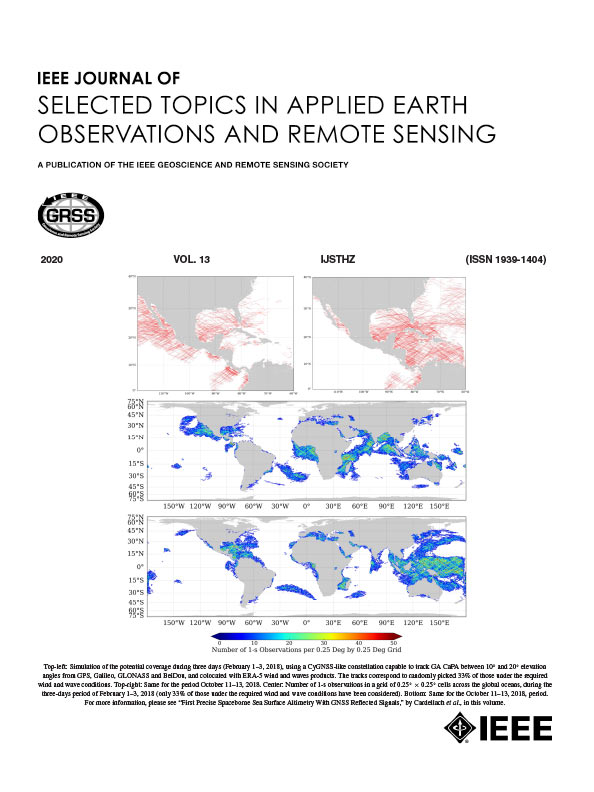High-Resolution Mapping of Forest Parameters in Tropical Rainforests Through AutoML Integration of GEDI With Sentinel-1/2, Landsat 8, and ALOS-2 Data
IF 4.7
2区 地球科学
Q1 ENGINEERING, ELECTRICAL & ELECTRONIC
IEEE Journal of Selected Topics in Applied Earth Observations and Remote Sensing
Pub Date : 2025-03-12
DOI:10.1109/JSTARS.2025.3550878
引用次数: 0
Abstract
Forests are vital carbon sinks, with tree height and biomass critical for carbon research. NASA's GEDI spaceborne LiDAR enhances vegetation monitoring through 3D structure analysis. This study established relationships between GEDI products and Sentinel-1/2, Landsat 8, ALOS, and GLO-30 features using the AutoML method. We constructed a total of 432 features, primarily from 14 types of earth observation features. In a 95.56% forest-covered area, AutoML improved canopy height (FCH) and biomass (AGBD) accuracy by up to 5.25 m and 32.18 Mg/ha over other methods. Polarization interference features, especially phase, explain 20% of forest parameters, showing high stability. Wavelet and Fourier-based texture features also demonstrate strong potential. Two mapping methods are proposed: 10 m resolution (FCH基于GEDI与Sentinel-1/2、Landsat 8和ALOS-2数据自动集成的热带雨林森林参数高分辨率制图
森林是重要的碳汇,树高和生物量对碳研究至关重要。NASA的GEDI星载激光雷达通过3D结构分析增强了植被监测。本研究使用AutoML方法建立了GEDI产品与Sentinel-1/2、Landsat 8、ALOS和GLO-30特征之间的关系。共构建了432个地物,主要由14类对地观测地物组成。在95.56%的森林覆盖率范围内,AutoML比其他方法分别提高了5.25 m和32.18 Mg/ha的冠层高度和生物量精度。偏振干涉特征,特别是相位,解释了森林参数的20%,具有很高的稳定性。基于小波和傅里叶的纹理特征也显示出强大的潜力。提出了两种映射方法:10 m分辨率(FCH $R^{2}$ = 0.53, RMSE = 11.49 m);AGBD $R^{2}$ = 0.53, RMSE = 133.56 Mg/ha)和500 m分辨率(FCH $R^{2}$ = 0.64, RMSE = 10.06 m;AGBD $R^{2}$ = 0.66, RMSE = 114.25 Mg/ha)。与现有地图相比(AGBD: $R$ <$ 0.1, RMSE $>$ 180 Mg/ha;FCH: $R <$ 0.2, RMSE $>$ 15 m),我们的方法(AGBD $R$ = 0.74, RMSE = 131.39 Mg/ha;FCH $R$ = 0.73, RMSE = 11.30 m)显著提高了精度。该方法对森林参数估计具有最小的饱和效应和广泛的适用性。
本文章由计算机程序翻译,如有差异,请以英文原文为准。
求助全文
约1分钟内获得全文
求助全文
来源期刊
CiteScore
9.30
自引率
10.90%
发文量
563
审稿时长
4.7 months
期刊介绍:
The IEEE Journal of Selected Topics in Applied Earth Observations and Remote Sensing addresses the growing field of applications in Earth observations and remote sensing, and also provides a venue for the rapidly expanding special issues that are being sponsored by the IEEE Geosciences and Remote Sensing Society. The journal draws upon the experience of the highly successful “IEEE Transactions on Geoscience and Remote Sensing” and provide a complementary medium for the wide range of topics in applied earth observations. The ‘Applications’ areas encompasses the societal benefit areas of the Global Earth Observations Systems of Systems (GEOSS) program. Through deliberations over two years, ministers from 50 countries agreed to identify nine areas where Earth observation could positively impact the quality of life and health of their respective countries. Some of these are areas not traditionally addressed in the IEEE context. These include biodiversity, health and climate. Yet it is the skill sets of IEEE members, in areas such as observations, communications, computers, signal processing, standards and ocean engineering, that form the technical underpinnings of GEOSS. Thus, the Journal attracts a broad range of interests that serves both present members in new ways and expands the IEEE visibility into new areas.

 求助内容:
求助内容: 应助结果提醒方式:
应助结果提醒方式:


